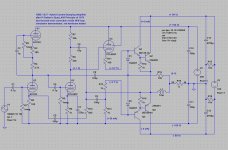With tubes ? - never - Peter Walker (R.I.P.) would be disgusted ...
With valves of course !
Well not quite ... the dumpers are BJTs or MosFets, so its actually a hybrid.
So far this is just a simulation exercise just for fun and discussion.
Along the lines of P.Walker's QUAD405 current dumping principles from WW 1975
aka Forward Error Correction inside NFB Loop.
Advantages ?
- could be 100 watt output to speakers or more
- or less, free choice of LV supply
- actually you could hook up the dumpers to the HV supply if you dared
- with less than 100mA @ 200V = 20W at idle
- no standing current in power stage
- hence no thermal compensation / bias adjustments
- still almost no crossover distortion
- power rail split borrowed from QUAD606 design
- hence single rail power supplies for Valves and Dumpers
- never any significant DC voltage across speaker
- note the ground terminal at one end of the speaker connection
- no need for speaker protection relay or crowbar circuit
Disadvantages ?
- many ... lets find out ...
- the class-A amplifier inside is not ideal with valves
- the original 405 had gm of 50,000 A/V compared to feeble 2 A/V
Here is some literature on the original sand version:
d.c. ~ daylight ltd - Analogue - Audio - Video - Electro-optic - Electronic Engineering support & Design Dumping Audio Amplifer DCD.pdf
http://quad405.com/jaes.pdf
d.c. ~ daylight ltd - Analogue - Audio - Video - Electro-optic - Electronic Engineering support & Design dumping - does it really work DCD.pdf
and attached the simulated demonstrator
With valves of course !
Well not quite ... the dumpers are BJTs or MosFets, so its actually a hybrid.
So far this is just a simulation exercise just for fun and discussion.
Along the lines of P.Walker's QUAD405 current dumping principles from WW 1975
aka Forward Error Correction inside NFB Loop.
Advantages ?
- could be 100 watt output to speakers or more
- or less, free choice of LV supply
- actually you could hook up the dumpers to the HV supply if you dared
- with less than 100mA @ 200V = 20W at idle
- no standing current in power stage
- hence no thermal compensation / bias adjustments
- still almost no crossover distortion
- power rail split borrowed from QUAD606 design
- hence single rail power supplies for Valves and Dumpers
- never any significant DC voltage across speaker
- note the ground terminal at one end of the speaker connection
- no need for speaker protection relay or crowbar circuit
Disadvantages ?
- many ... lets find out ...
- the class-A amplifier inside is not ideal with valves
- the original 405 had gm of 50,000 A/V compared to feeble 2 A/V
Here is some literature on the original sand version:
d.c. ~ daylight ltd - Analogue - Audio - Video - Electro-optic - Electronic Engineering support & Design Dumping Audio Amplifer DCD.pdf
http://quad405.com/jaes.pdf
d.c. ~ daylight ltd - Analogue - Audio - Video - Electro-optic - Electronic Engineering support & Design dumping - does it really work DCD.pdf
and attached the simulated demonstrator
Attachments
Just stumbled over this issue:
what happens when tubes heat up but are not fully conducting yet.
Will this play havoc with voltages, cause damage ?
After all, everything except the initial stage is DC connected.
Especially in the case should the cathode follower pentode conduct before the triode in front of her. Then the pentode's grid would be close to the positive rail, which does not sound good.
what happens when tubes heat up but are not fully conducting yet.
Will this play havoc with voltages, cause damage ?
After all, everything except the initial stage is DC connected.
Especially in the case should the cathode follower pentode conduct before the triode in front of her. Then the pentode's grid would be close to the positive rail, which does not sound good.
- Status
- This old topic is closed. If you want to reopen this topic, contact a moderator using the "Report Post" button.
